8th Evacuation Hospital Unit History

Illustration showing Officers of the 8th Evacuation Hospital in front of the Italian Consulate. Photograph taken in Casablanca, December 1942.
Early History & Activation
The 8th Evacuation Hospital can trace its roots back to Base Hospital No. 41, activated on the eve of World War 1. Both units had been sponsored by the University of Virginia in Charlottesville, and the respective commands drawn from the local population. Dr. Staige D. Blackford, of the University’s Medical School felt that the University should not only be able to continue to operate as a Medical School during WW2, but that it should also be capable of providing a medical unit. Blackford took upon himself the task of persuading the administration of the University that the formation of the unit was both desirable and feasible; he also assumed the responsibility for recruiting the personnel after permission had been granted from the University and the Surgeon General’s Office.
News spread quickly of the University’s plan to sponsor a medical unit, and on 4 February 1942, the “Daily Progress” announced the plan to Charlottesville, indicating that the unit would most likely take the form of a 750-bed Hospital. Little more than 20 days later (27 February), President Newcomb of the University received a letter from the Adjutant General indicating that the proposal for sponsorship had been approved by the Secretary of War, and that the Hospital would be organized as the 8th Evacuation Hospital.
As part of its agreement, the University was required to find the necessary personnel to bring the 8th Evac Hosp up to T/O strength (comprising 417 personnel). Sectors of the University were not expected to provide personnel for there were the Enlisted cadre (Noncommissioned Officers and Privates), 3 Dental Officers and 2 Chaplains. Despite this fact however, some in each category were provided by the organization. Dr. Staige D. Blackford became Chief of Medicine, and continued the overall supervision of the unit, while Dr. E. Cato Drash, an associate professor, became Chief of Surgery, and was in turn responsible for procuring the Officers needed for the surgical service of the unit. As part of the recruitment process, Blackford had chanced upon Miss Ruth Beery, formerly a science instructor in the School of Nursing at the University. Beery was soon appointed as Chief Nurse, commissioned a 1st Lieutenant in the ANC and began the recruitment of the required Nurses. The personnel worked quickly, and the organization of the unit was virtually complete before 1 May 1942.

Photograph showing Nurses of the 8th Evacuation Hospital. Picture was taken at Anfa Hill, Casablanca in March 1943.
Time passed as the remainder of the unit’s personnel (Enlisted Men and Nurses) was recruited into the unit and it was expected that the 8th Evacuation Hospital would be formally activated on 1 September 1942. To provide field experience during July and August, the Surgeon General recommended that the members of the University unit apply for active duty. Although this was done individually by some of the Officers and personnel, it was planned to assign all personnel to the 3d Evacuation Hospital, then stationed at Fort Benning, Georgia until the unit was officially activated. From 23 August to 16 September, the unit’s personnel accompanied the 3d Evac Hosp at Ft Bragg, home of the Infantry School. During this period the unit was officially activated as the 8th Evacuation Hospital in compliance with Section XI, General Orders No. 85, Headquarters, Second United States Army of 19 August 1942. The Order commanded the transfer of 3d Evac Hosp personnel to the newly formed unit.
Training in the Z.I.:
On 16 September 1942, after numerous temporary alerts, the unit’s personnel finally climbed into trucks that took them to the railroad station, where they boarded an all-Pullman train for Camp Kilmer, Stelton, New Jersey. At 0345 hrs the following day, the train arrived at Cp. Kilmer and the men immediately detrained to a rumor that the unit was headed immediately to an overseas destination via ship. The rumors proved false, and after a mile-long march, the new quarters were reached, striking a strong resemblance to the barracks left behind at Ft. Benning, Ga.
Over the next three months, training would be rigorous. The Officers’ training period consisted of a routine of calisthenics and drill in the morning, lectures and athletics in the afternoon. The professional activity consisted of assisting the Station Hospital complement perform the final type physical examinations on troops who were about to be sent overseas. The examinations and practices bore little resemblance to those that had been encountered in the private sector, so the time at Cp. Kilmer proved to be a steep learning curve for the Officers, many of whom had closed down private practices prior to enlisting in the Army.
The stay at Cp. Kilmer provided an ideal opportunity for the Chiefs of Service to review the personnel roster of the unit carefully. Each man was interviewed and his record studied to learn about his past work experience, and training in civilian life as well as in the Army. As a result of the findings of this research, numerous changes were made in the section assignments. By this stage, approximately 2/3 of the unit’s best-trained men had been lost in cadres to other units. To remedy the situation, Colonels Drash and Blackford, accompanied by ten Nurses took a group of 100 replacements for a series of two-hour lectures on the meaning of sterile technique and the care of patients. The course also included instruction in special procedures, such as taking temperatures, making beds, and giving injections and enemas.
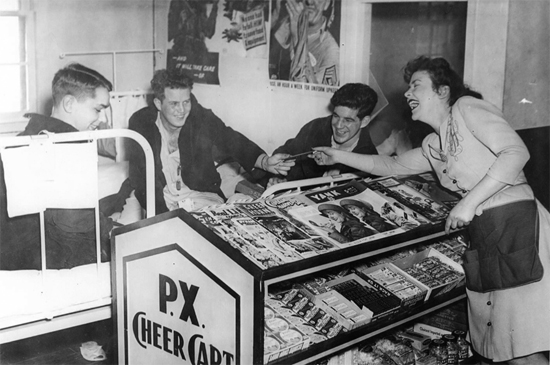
Bed-ridden patients at the Station Hospital, Camp Kilmer are delivered items from the camp PX Store by Hospital personnel.
On 8 October 1942 news was received that the Nurses would not accompany the unit in its move overseas, but rather be kept together and join the Hospital as soon as the Corps Surgeon considered it safe and expedient; until such a time, the Nurses were to be assigned in groups of 8 or 10 to various Station Hospitals. As replacements, 30 Officers and 61 Enlisted Men of the 2d Auxiliary Surgical Group were attached to the 8th Evac Hosp.
Life at Cp. Kilmer was filled with frustration – the food served was the worst the unit had encountered in the Army, and Officers were prohibited to buy sandwiches and other food at the Post Exchanges. They were not permitted to use the telephones in the barracks, which meant hours waiting in line at the Post Exchange in the hope of getting into one of the telephone booths. This, coupled with the numerous false alerts meant the vast majority of the unit had little else to do during the day besides pitching a football, playing poker or simply reading magazines and old newspapers.
Orders were received on 1 November for the unit’s departure from Cp. Kilmer (staging area for NY/POE). The Enlisted Men were paid in full at 0400 hrs, breakfast was served at 0630 hrs and the barracks emptied by 0715. An hour later, all personnel assembled according to the passenger list and at 0915 hrs the one-mile march to the train began with barracks bags and ‘valpacks’ accompanying the troops in trucks. The train departed at 1035 hrs for Jersey City, where the unit was to detrain, march approximately one more mile and board the Staten Island ferry. Upon reaching Pier 11, the unit quickly filed off the ferry and boarded the USS Santa Paula. By 0400 hrs on 2 November 1942, the unit was now on its way overseas; with destination, Africa.
Operation Torch
On the third day of the voyage, secret orders were opened and disclosed that the convoy was the second echelon of an amphibious assault on Casablanca, French Morocco; the first echelon being five days ahead. All Commanding Officers received maps of the area and detailed instructions for their respective units. All other Officers and troops received pamphlets on Northern Africa and attended lectures on the Arabs and Arabic customs. Despite its scarcity, news reached the ship on 8 November that US forces had entered and taken Algiers, as well as occupying Oran, an important naval base. A day later, all currency was collected from the troops and replaced by equal amounts of invasion currency, which was to be legal tender upon landing. In total, $17,000 was collected from the 8th Evac Hosp personnel and exchanged.
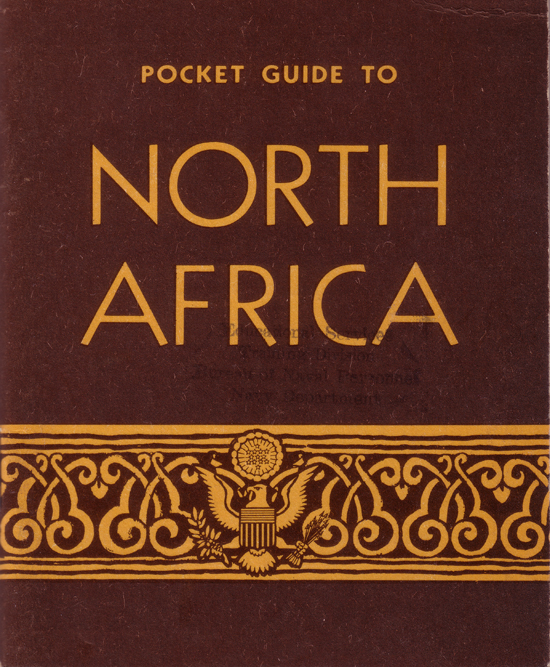
Illustration showing the front cover design of the pamphlet issued to Officers and Enlisted Men of the 8th Evac Hosp in preparation for their arrival in North Africa. This particular item was prepared by the U.S. Government Printing Office in 1942.
During the night of 18 November, the USS Santa Paula slipped into the harbor of Casablanca. A communion service was held in the ship’s recreation room at 0630 hrs by Chaplain Laird. The next day was spent largely on deck, awaiting further instructions, which came on 20 November. Breakfast was served at 0430 and by 0700 hrs the members of the unit were in line preparing to debark. The uniform was wool, with Field Jacket, M1 Helmet, Leggings and Field Pack; each man wore an American Flag brassard on the left arm. At 0900 sharp, the men began climbing down the nets into waiting barges below.
Having assembled once ashore, the unit marched approximately 3 miles along wide avenues to its destination at Bainville. Upon arrival, the unit encountered a major problem, the building in which it was to establish a 750-bed hospital was jammed with personnel of the 11th Evacuation Hospital (it later moved to Rabat), the 56th Medical Battalion and the 2d Auxiliary Surgical Group – all of whom had arrived on the same convoy! Discussions and arguments broke out between the 8th and 11th Evac Hospitals about who was in command and who was to occupy the building. A rainstorm that evening forced all personnel into the already-crowded building, and saw Officers sleeping on marble floors, while enlisted personnel bivouacked on a nearby city dump. For the first several days, members of the unit ate K-Rations, and then C-Rations. Although palatable and more nourishing than the K-Rations, they soon became monotonous and all members of the unit were glad when “Thanksgiving Day” marked the beginning of B-Rations, which would form the main ration for the remainder of the war.
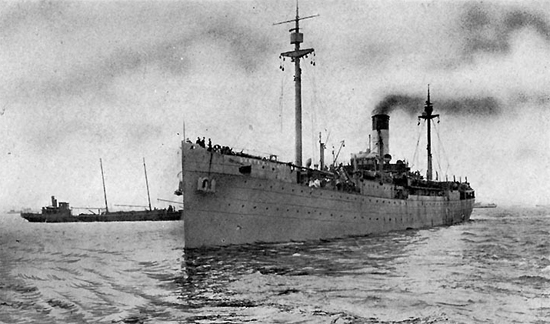
Photograph showing the USS Santa Paula
A week passed before the other units also in the building began to move to other locations. The 8th Evac wasted no time however, and in the meantime began to set up its Hospital on 21 November 1942. The first patient was received the following day – Pvt. Adam Guy (ASN 35123415) of the 23d Quartermaster Battalion. He was to be the first of thousands who would be treated in the rooms whose walls were adorned with Mussolini’s slogans.
French Morocco station
8th Evacuation Hospital (fixed Hospital)
Casablanca 22 Nov 42 > 19 Jun 43
The experience of the 8th Evac Hosp in Casablanca demonstrated that the Army had to relearn one of the lessons it had learned in the Civil War, that Army Hospitals should be either set up in tents or in a building constructed for a Hospital; other structures such as schools, warehouses, and hotels were generally considered unsuited. Although patients were being treated two days after landing, and a week before the Hospital officially opened, weeks had elapsed before procedures were functional and safe. During the unit’s time in North Africa, nothing went as expected – plans were discarded in favor of ingenuity, hard work and improvisation.
Obtaining the necessary hospital supplies and equipment was difficult. The work of unloading the first convoy was erratic and disorganized, and men worked night and day to unload the trucks. Despite this, however, the supplies were scattered in numerous dumps and representatives from the numerous other Medical units in the area stalked the dumps for anything that bore a Caduceus or other Medical Department identifying mark. Correct equipment was not present for a number of weeks, and indeed no x-rays could be taken until Captain Den, who was in charge of Roentgenology, found some essential equipment beneath the stands at a race track, taken there by another Medical unit and discarded.
The wards officially opened for patients on 29 November, which introduced further problems for the Hospital staff. Due to the confusion and lack of correct equipment, the first day saw medical and surgical patients being mixed indiscriminately in the wards, taking a further day to sort through each patient and once again determine their case. During this time, Officers were quartered in a Jewish school a mile from the Hospital. The Officers traveled to the Hospital either on foot or bicycle, where all meals were served.

Photograph showing four M-1934 Pyramidal Tents of the 8th Evacuation Hospital at Teano. Cassino can be seen in the background. Of interest is the white Greek cross applied to the pitch of this Pyramidal Tent.
On 8 December it became necessary to open an annex for convalescent patients in a former French Maternity Hospital, “La Dispenserie Maternelle ”, situated on the Boulevard des Régiments Coloniaux. The new complex was operated by 24 Officers and 27 Enlisted Men of the 2d Auxiliary Surgical Group. Further expansion to the Hospital came on 17 December, when it became necessary to establish a VD clinic, which consisted of ten Ward Tents pitched on a vacant area along the Boulevard. Again, this unit was operated by the 2d Aux Surg Gp until 13 February 1943 when the staff were replaced by 4 Officers and 44 Enlisted Men of the 1st Platoon, Separate Ships Hospital. Both the annex and clinic were under the administration and professional supervision of the 8th Evac Hosp.
New Year’s Eve brought the unit its first air raid. The Hospital staff was awoken at 0330 hours to the sound of German bombers overhead. All staff that was not present at the Hospital immediately made their way to the complex. There was much excitement and confusion, since no one seemed to know what should be done. Some patients ran around on the Hospital’s roof in order to try and get a better view of the event, while others congregated in the courtyard to yell encouragement to the anti-aircraft crews stationed in batteries around the complex. The all clear was sounded at 0730 hrs, at which point it became clear that Pvt J. W. Kelly of the attached Ambulance Platoon had been wounded in the thigh – the only casualty of the affair.
On 17 January 1943 Lt. Colonel Putnam suffered a perforated ulcer which caused major abdominal discomfort. He was operated on immediately that night, and the following day received orders promoting him to Colonel, effective 31 October 1942. Immediately following the promotion, Lt. Colonel E. C. Drash was appointed temporary CO and on 28 January, Putnam was returned to the ZI. The loss of Putnam came as a major regret to the unit, which had relied on Putnam’s expertise and service with Fitzsimons General Hospital in the ZI.
The efficiency of the Hospital was enhanced on 20 January when 39 Nurses of the 91st Evacuation Hospital were attached. These Nurses remained with the 8th Evac until its operation as a provisional General Hospital came to an end on 8 March 1943. Their skill and industry brought needed improvement in the functioning of the operating room and the wards. The presence of the Nurses and their feminine touch also meant a great deal to the morale of the sick and wounded.
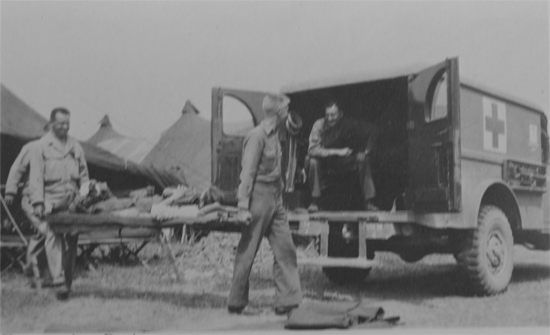
Patients are evacuated from the 8th Evacuation Hospital by means of a WC-54 Ambulance.
The unit began to cease operations on 7 March, when the group of Nurses from the 91st Evac Hosp was returned to its unit at Port Lyautey, French Morocco. All patients were evacuated to the 6th General Hospital which had arrived from the ZI several weeks earlier. By 13 March the evacuation of all patients had been completed and the equipment packed. On 14 March the unit moved to a new location on Anfa Hill where it began to function as a Convalescent Hospital 4 days later. On the same day as the opening, Lt. Ruth Beery and 51 Nurses arrived in Casablanca on the S/S John Ericsson. Since the 8th Evacuation Hospital’s arrival in Casablanca, the Nurses had been attached to the newly completed Halloran General Hospital on Staten Island. There, they treated patients who had been returned from Field Hospitals in Casablanca and the North African Invasion, including some who had been treated by the 8th Evac Hosp. On 20 February 1943 the Nurses had returned to Cp. Kilmer for two weeks of staging, finally embarking for Casablanca on 4 March.
The two months that the unit operated the Convalescent Hospital was an easy time of light duty for the Medical Officers. Nevertheless, this period proved to be a valuable one for the Hospital. Again, opportunity was provided to reassign personnel to the jobs for which they seemed the best fitted. The actual operation of the Hospital with a light load of patients provided an excellent opportunity for training the men who were assigned to the professional services. Of equal importance was the proficiency gained by the groups assigned to the tent-pitching details; eventually by developing unorthodox and non-regulation methods these men routinely erected and aligned tents in half the time required by Army Regulations.
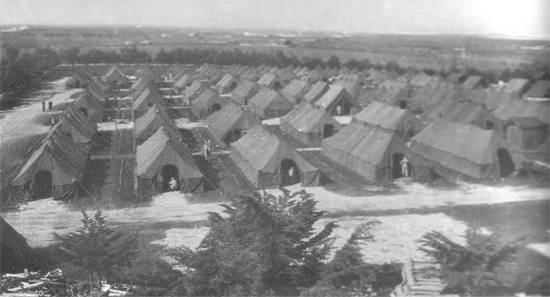
Illustration showing the tented hospital of the Unit at Anfa Hill, Casablanca during the spring of 1943. Notice the mix of Hospital Ward, Large Wall and Storage Tents in this picture.
On 9 May, most of the hospital’s personnel attended a colorful ceremony in the Place Lyautey to celebrate the Tunisian Victory and the birth of a new French Army.
The Hospital was reassigned to the I Armored Corps on 25 May and by 5 June 1943 it was dismantled, all boxes were packed and marked and the Hospital went into bivouac on the alert to await movement orders. With prospects for a part in an invasion somewhere in the Mediterranean, a physical fitness regime was instituted with baseball, softball, volleyball and swimming at the nearby beach. Bicycles, footlockers, ping-pong tables, tent flooring and other things that had become excessive were given to friends in the 45th General Hospital located in Rabat.
Between 26 November 1942 and 10 March 1943, the 8th Evacuation Hospital operated as a 400-bed Provisional General Hospital in the buildings of the Italian Consulate and School (later taken over by the 66th Station Hospital). The surgical patients and the sickest medical patients were kept in the main unit of 17 wards at the consulate. This unit was operated by the 52 Officers and 375 Enlisted Men of the Medical Detachment of the 8th Evac Hosp; the work being facilitated by the addition of 38 Nurses from the 91st Evacuation Hospital. Important work was also carried out by 24 EM of First Platoon, Company A, 36th Motor Ambulance Battalion who were attached for duty on 24 November 1942. During its time in Casablanca, the 8th Evac Hosp admitted 4,192 patients, of which 3,522 were classified as disease, 609 as injury and 61 as battle casualty. The convalescent annex had 859 admissions and the venereal disease clinic, 602. In the medical outpatients department, 1,380 patients were treated, over 1,500 vaccinations given and about 3,500 physical examinations made. During the period 18 March to 19 June 1943, when the Hospital functioned as a Provisional Convalescent Hospital on Anfa Hill, 1,459 patients were admitted. Of these 706 were classified as diseased, 433 as injured and 320 as wounded. All patients were evacuated to duty (52%), transferred to other Hospitals (13%), or evacuated to the ZI (35%).
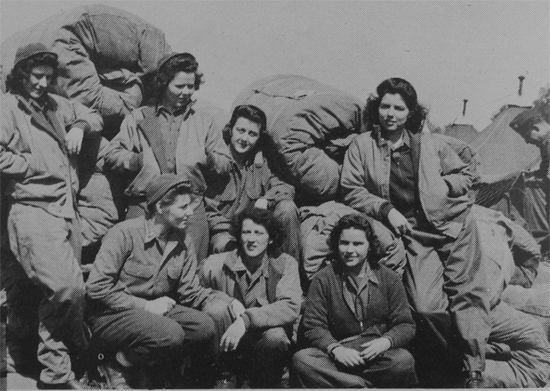
Nurses of the 8th Evac Hosp prepare for movement out of Casablanca in July 1943.
The unit was finally on the move out of Casablanca on 21 July 1943.
Sicily & Algeria:
On 19 June 1943 a Detachment of 11 Officers and 33 Enlisted Men was formed from the 8th Evacuation Hospital by order of the Atlantic Base Section. This group was directed to proceed from Casablanca, French Morocco to Bizerte, Tunisia, where it was to report to Admiral Connelly, USN for a secret mission. The Detachment was commanded by Major Maurice L. LeBauer, MC, and a day later left the 8th Evac Hosp bivouac in three 2½-ton trucks and trailers. The unit had been provided with 8 days rations and joined a similar Detachment from the 59th Evacuation Hospital and traveled approximately 1,300 miles to Bizerte in five and a half days.
On 27 June the Officers and Enlisted Men were assigned to LSTs with one Officer and three men to each vessel. The following assignments were made, and are taken from the Adjutant’s Diary, June 27, 1943:
| LST No. | Officer | Enlisted Personnel |
| 1 | Maj. Maurice L. LeBauer | T/5 Robert L. Pond Pfc. John T. Stich Pfc. George Kokinakis |
| 3 | Capt. Donald P. Watson | T/5 Egbert E. Mullins Pfc. Lloyd H. Bollinger Pvt. C. Perry |
| 158 | Capt. John B. Haley | Pfc. George W. Child Pfc. Wilson I. Smith Pvt. Albert Harlan |
| 349 | Lt. John R. Mapp | T/5 Cecil A. Milling Pvt. James B. Shepperd, Jr. Pvt. Charles T. Liles |
| 374 | Capt. John L. Guerrant | Pfc. George F. Evans Pfc. Adam E. Naporski Pvt. Edward C. Denny |
| 375 | Capt. James W. Culbertson | T/5 Harold W. Key Pvt. Yale Cohen Pvt. Orval K. Whitman |
| 376 | Lt. Henry W. Mayo, Jr. | T/5 Raymond F. Gasiorowski Pfc. Samuel Curtis Pfc. John Cortese |
| 377 | Lt. William D. R. Driscoll | T/4 Charles C. Carpenter Pvt. Louis Frank Pvt. Martin E. Stafford |
| 378 | Lt. James R. Low | T/5 John C. Smart Pfc. Origen C. Hall Pfc. Avery |
| 379 | Lt. Beverly D. Hairfield | T/5 Nash B. Obenchain Pfc. John J. King Pvt. John J. Amrozy |
| 383 | Lt. Herbert M. Smith, Jr. | Pvt. Herman L. Brush Pvt. Thaddeus J. Kuna Pvt. Raymond H. Dresse |
Both Officers and EM were ordered to bivouac in a hangar on the dock of the Karouba Naval Base in Bizerte to await further orders. On 9 July the armada, composed of units which had sailed from many different Mediterranean ports, assembled near the island of Malta. As the Invasion force came together, a severe storm developed suddenly and caused considerable apprehension. Fortunately, the storm subsided and the initial landings began as scheduled on 10 July. This was the first time that Americans had used the amphibious load carriers, DUKWs, and LSTs in an invasion.
Between 9 July and 7 August, most of the LSTs to which members of the 8th Evac Hosp were assigned made three or four trips to Sicily, mainly to Licata, but also to Gela, Syracuse, Palermo and Porto Empedocle. LST 158, on which Capt. Haley, Pfc. Child, Pvt Smith and Pvt. Harlan served, was wrecked by bombing on the first trip; Captain Haley was hospitalized with multiple contusions. In another action, Pvt. Cortese, T/5 Pond and Pfc. Hall received superficial shrapnel wounds.
The remainder of the 8th Evacuation Hospital did not move from Casablanca, French Morocco, until ten days after Sicily was invaded. On 21 July the advance party of about 40 Officers and Enlisted Men left Anfa Hill for the next destination by motor convoy, while the main body boarded a troop train at Casablanca at 2000 hrs. Officers and Nurses were assigned to coaches, which proved to be infested with lice. Enlisted Men were assigned to “40 & 8” boxcars. The troop train departed at 0100 hrs on 22 July 1943. Over a period of 11 hours, the train covered a total distance of 12 ½ miles, finally arriving at the train station at Algiers at 0400 hrs on 25 July. The troops detrained and immediately climbed aboard trucks which took them to the new location at Cap Matifou. The second echelon arrived ahead of the advance party, but the 79th Station Hospital came to its rescue when it loaned the unit a water trailer and fed the members.
The next six weeks proved to be little more than an unneeded vacation. About the only medical activities were lectures and training sessions for ward and laboratory Technicians. Escape from the wind and dust of the bivouac area and diversions of various sorts were also provided by trips to Algiers. In the bivouac area life became more interesting when British antiaircraft units moved in “next door”. Both the British and the Americans seemed to find their Allies nicer and more agreeable company than they had expected. The main excitement occurred on 28 August, when all troops at the Hospital were awakened at 0400 hrs by bugle calls and cries of “To Arms!” “To Arms!” “Air Raid!” Members of the unit hurried to a trench across the road where it spent the next two hours while Luftwaffe planes were overhead. Out of 42 bombers sighted by the surrounding AA units, only 3 were downed in the raid, which was reportedly against the harbor at Algiers.
The Sicilian Campaign ended on 17 August. The Allies had accomplished all of their stated objectives but had been unable to prevent a force of 60,000 Germans from escaping across the Strait of Messina to continue the war in Italy. With the ending of this Campaign it became evident that the 8th Evacuation Hospital would become part of the Fifth United States Army‘s assault on Italy.
Italy
Colonel (later Major General) Joseph I. Martin, MC, who became Fifth US Army Surgeon in April 1943 and Col. Jarrett M. Huddleston, MC, VI Corps Surgeon, directed the medical planning for the Salerno assault (Operation Avalanche). Although the Fifth Army was activated on 5 January 1943 at its headquarters at Oujda, French Morocco, it was given only six weeks to plan for the Invasion of Italy in early September. As in Sicily, each division was to be supported by one 400-bed Evacuation Hospital. In addition, there was to be one 750-bed Evacuation Hospital in reserve for each division. The mobile hospital units assigned for Operation “Avalanche” were as follows:
15th Evacuation Hospital (400-bed) with combat experience
93d Evacuation Hospital (400-bed) with combat experience
94th Evacuation Hospital (400-bed) with combat experience
95th Evacuation Hospital (400-bed) with combat experience
8th Evacuation Hospital (750-bed) with combat experience
16th Evacuation Hospital (750-bed) with combat experience
38th Evacuation Hospital (750-bed) with combat experience
56th Evacuation Hospital (750-bed) with combat experience
4th Field Hospital (less one platoon) with combat experience
10th Field Hospital with combat experience
11th Field Hospital with combat experience
32d Field Hospital fresh from the US
33d Field Hospital fresh from the US
The 3,000-bed 3d Convalescent Hospital was also included. Six 500-bed Station Hospitals and four 1,000-bed General Hospitals were to arrive 45 days after the invasion. Thus provision was made for 9,500 mobile beds and 7,000 fixed hospital beds in connection with the invasion. More detailed planning called for the 95th and 16th Evacuation Hospitals, less Nurses, to land on D-Day; the 15th, 93d, and 94th Evacuation Hospitals were to land on D+6, while the 8th and 38th Evac Hospitals were scheduled for D+12.
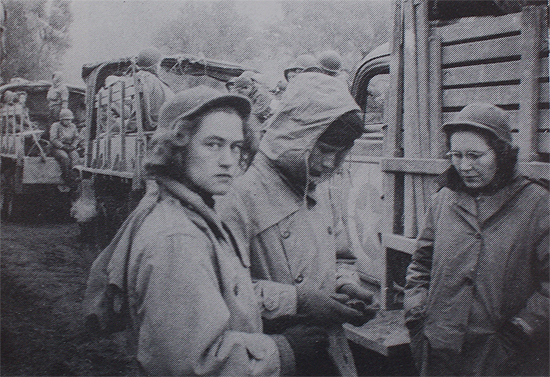
Lieutenants Hilde Franklin and Rosalyn Williams of the Army Nurse Corps prepare to board 6×6 Trucks that will take them to the Hospital’s new location.
The 8th Evac Hosp departed Goat Hill early on the morning of 15 September 1943. After traveling for most of the day, and having missed the boat (the S/S Durban Castle) once, the unit finally boarded at the Oran docks. Although loading of all personnel and equipment had been completed that night, the ship did not depart until 17 September. By D+12 (21 September), there was reveille at 0415hrs and breakfast at 0500. The unit was scheduled to leave the ship at 0615, but it was mid-afternoon before personnel of the 8th Evac Hosp (together with the 38th Evac Hosp and the 52d Med Bn) made it on to the landing barges which would take them ashore at Blue Beach, near Paestum (Gulf of Naples) Italy.
Upon landing, the personnel were met with confusion and chaotic vehicle movement. Eventually, trucks from a medical unit picked up members of the Hospital and carried them about 15 miles to a hilltop. Nurses were already bivouacked in the area when the men arrived. The area, apparently the site of a Battalion Aid Station a few days earlier, contained slit trenches, foxholes, blood-drenched bandages, K-Ration boxes and a crashed German aircraft. The entire 8th Evac Hosp personnel reached the area at approximately 2400. Many had diarrhea and a wing from the downed plane was placed against a tree beside a foxhole to form a screened latrine for the Nurses. About 0100, a jeep from the 162d Medical Battalion brought some much-appreciated hot coffee and wool blankets.
Early anticipation and excitement was short-lived however, when news was soon received that the S/S William Gerhard had been sunk. This ship had been carrying the Hospital’s equipment, and nothing was salvageable. Soon, trucks arrived and carried all the personnel back to an open field adjacent to the 16th Evacuation Hospital near Paestum, where the unit was to pitch shelter tents.
The week after it landed in Salerno was one of the most anxious periods that the 8th Evac Hosp experienced. Foremost in most minds was the fear that the Hospital would be broken up and its personnel sent as replacements to other units. This stemmed from two widely held opinions. The first was that it would be near impossible to reequip a 750-bed unit in a combat zone within a reasonable time; the second was based on the recurring rumor that the “affiliated units” Hospitals which were staffed by personnel supplied by the medical schools, would be broken up because they had an overabundance of professional talent compared with many non-affiliated hospital organizations in the Army.
Determined to help themselves, the personnel of the 8th Evac Hosp set about trying to locate and replace the missing equipment. Within 48 hours of having received the news of the loss of all equipment, Ward and Pyramidal Tents, a telephone system, and a generator had been procured. A British Hospital unit which had taken over an Italian civilian Hospital in the town of Salerno provided both matériel and moral support when it let the unit have a microscope and other equipment necessary to run a laboratory in a field unit. By the end of the week, the Hospital had been visited by Brigadier General Frederick A. Blessé, NATOUSA Surgeon, who confirmed that the unit would definitely be reequipped, and that sufficient equipment for it to function as a military Hospital would be available in a matter of weeks. The General’s original intention had been to send the unit back to Africa, where it would be reequipped.
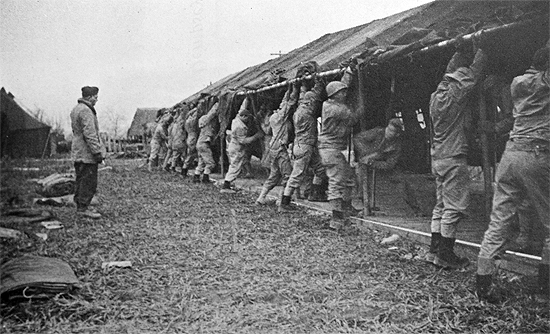
Enlisted personnel of the Unit erect a Hospital Ward Tent in Italy, 1944.
Life in the bivouac area in the Muskrat Meadow (adjacent to the 16th Evac Hosp) was largely reduced to fundamentals – eating, sleeping and waiting. Uniforms were HBT coveralls, socks, shoes and helmets. During the three-week period between the landings at Salerno and the time when the Hospital received the first medical patients, personnel of the 8th Evac were utilized in various ways. Over 200 individuals were sent to assist the 16th Evacuation Hospital and other medical organizations in the area. Captains Den and Leavell were sent on detached service to the 94th Evacuation Hospital near Battipaglia. Captains Shearburn and Payne; 1st Lieutenant Mapp; Sergeants Yost, Bladwin and Waller; Corporal LeVan; Technician Nau; and Privates Montgomery, Ward, Wolka, and Perotti were ordered to Headquarters, Fifth US Army. They were sent to Capri, Ischia and other islands near the harbor of Naples to make a survey of the sanitary conditions.
On the night of 28 September a severe rain and electrical storm swept the center of the 16th Evacuation Hospital, leveling the tents and demolishing the installations (it also damaged the 95th Evac Hosp). At the time, the Hospital had 961 patients, and the surgical tent was in operation. Personnel of the 8th Evacuation Hospital, bivouacked in the adjoining field helped replace lost and scattered records of the Hospital and took over the care of patients who were evacuated to barns and a tobacco warehouse nearby. Personnel of the unit, 12 Officers, 22 Nurses and 55 Enlisted Men, continued to operate this facility as an annex of the 16th Evacuation Hospital’s Ward. During the period 29 September to 11 October 1943 a total of 1,131 patients were cared for. Malaria, hepatitis, neuropsychiatric disorders, diarrhea and respiratory infections constituted the majority of the diseases.
Between 12 and 13 October, the 8th EH moved to Caserta, three or four miles south of the Volturno River, where it opened on 16 October. There, the unit occupied part of a complex of eight yellow stuccoed buildings arranged around three sides of a rectangle, several hundred yards long. There was ample space for the 8th and the other units that joined it there: the 38th Evacuation Hospital, the 33d Field Hospital and the 2d General Hospital.
Although its equipment consisted mainly of folding cots and blankets, the 8th Evac Hosp began to receive non-operative patients on 15 October 1943 and admissions increased until exceeding 1,000 patients. In the early part of this two-month period, Hospital personnel made numerous trips to the surrounding medical units to see what equipment could be borrowed or salvaged. Surgical instruments, centrifuges, microscopes and other items were obtained. By the latter half of the month, large supplies of Medical Department equipment had arrived. Because of the limited nature of the equipment, the vast majority of the patients with the unit at Caserta were admitted to the medical service.

Hospital Laboratory Technicians hard at work in the fully winterized Hospital complex.
During the first few weeks, German air raids became an almost nightly occurrence. This period saw some changes in the personnel of the unit. Capt. Marshall and 1st Lieutenant Mayo were transferred to the 3d Infantry Division. Capt. Payne was transferred to the 53d Quartermaster Battalion and Capt. Casscells returned to the 8th Evac Hosp from the 53d QM Bn.
Between 16 October and 10 December 1943, a total of 3,915 patients were admitted to the Hospital; of these 3,358 were classified as diseased, 238 as injured, and 319 as wounded. In addition, 3,152 patients were seen in the out-patient clinic; the dental and EENT clinic each treated about 1,200 patients. The commonest diseases seen were hepatitis, malaria, respiratory infections (mainly bronchitis), psychoneurosis, and psychosis. On the surgical service, trench foot, shrapnel wounds, fractures and sprains were the commonest diagnoses. About 1/3 of the patients were returned to duty and 1/3 were transferred to General or Station Hospitals.
It was a period of relatively ‘light’ duty and comparatively pleasant living – the only time in two years that the unit had been quartered in buildings. As pleasant as these things were, the unit was ready and eager to get into the field when its turn came in mid-December. On 16 December, the unit moved 20 miles north on Highway 6 to an area near the village of Teano. Due to recent torrential rain, the organization was unable to function for the first two days in this area because numerous truckloads of rock were needed before the roads could be made passable for ambulances. At times, the ever present problem was mud, ankle deep, even in the aisles of the Ward Tents, which proved particularly miserable for the litter bearers.
Due to the continued artillery fire nearby, casualties were frequent at the Hospital; so much so in fact that on several occasions receiving, shock and surgery were full and additional patients overflowed into the tents in the administrative section. At times, many of the admissions were severely wounded with multiple chest and abdominal wounds, head and facial wounds, traumatic amputations, all the mutilating wounds that are produced by mines and high-explosive shells.
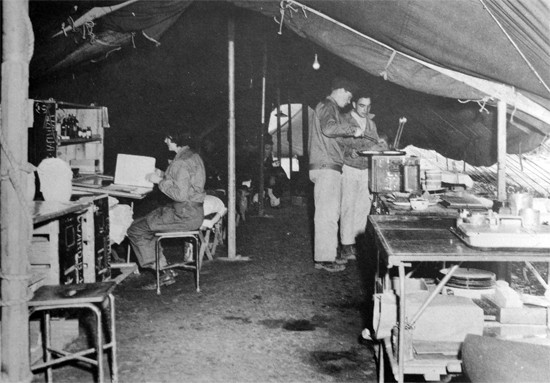
Winterized Medical Ward at the 8th Evacuation Hospital.
A visit was paid to the patients at the hospital on Christmas morning 1943 by Lt. General Geoffrey Keyes (CG, II Corps). The afternoon saw a further visit from Lt. General Mark W. Clark (CG, Fifth US Army), who spoke to the wounded at the Hospital for approximately one hour. He was followed by Brig. General Joseph I. Martin (Fifth US Army Surgeon).
On 25 January 1944 a three-hour truce (Sant’Angelo sector) was called in the afternoon to allow medics of both sides to cross the Rapido River and attend to their casualties. Between 1400 and 1700 hrs, German guides led men from two Medical Collecting Companies belonging to the 111th Medical Battalion through the mine fields. Many of the wounded had remained where they had fallen for several days without food or water.
While the unit was located at Teano, Capt. William Gerhard Suhling, MAC was transferred out of the unit. An alumnus of the Episcopal High School and the University of Virginia, and a veteran of World War I, he was a close friend of Lt. Col. Blackford. Always anxious for a more combative role in the Army, he was transferred to an OSS unit also in Italy at the time. With this transfer, the Hospital lost a valuable Officer, and many considered him a close friend.
During this period, the 8th Evac Hosp was administered by 46 Officers, 53 to 58 Nurses, 1 Hospital Dietitian, 2 American Red Cross workers and 304 Enlisted Men. In addition, surgical groups were attached at various times. Throughout the period Lt. James R. Boston, MAC, and 23 men from the 551st Motor Ambulance Company were attached. The Hospital also had the benefit of the work of about 30 Italian civilians, who were employed for general work about the area and as woodcutters and dishwashers.
As part of the reshuffling of the troops on the Cassino Front before the attacks of the Spring Offensive, the 8th EH and most of the other Evacuation Hospitals on the southern front were grouped in the vicinity of Carinola, adjacent to Highway 7 (mainly serving II Corps) and near the railroad that ran parallel to it. The first echelon of the unit moved from Teano to Carinola on 26 March and set up in an open grain field. This basic unit comprised headquarters, shock, operating room, x-ray, laboratories and a number of ward tents; it was set up and ready to receive patients only four hours after arriving in the area. At the time the unit worked together with the 601st Medical Clearing Company operating a small neuropsychiatric hospital.
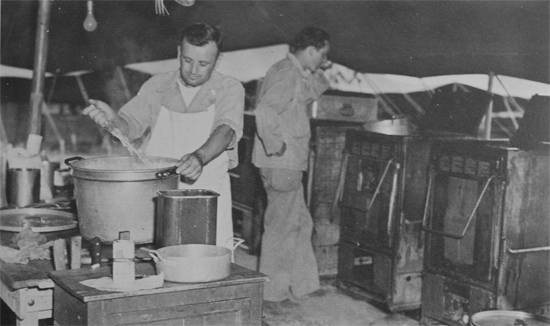
M1937 Field Ranges are used in the Field Kitchen to prepare meals for the personnel of the 8th Evacuation Hospital
After six weeks of shifting troops and re-equipping units, the Spring Offensive began on 11 May 1944. Casualties began to arrive from approximately 2300 hours, and at times there were 40 or 50 patients waiting for a vacant operating table. After four or five days, the Allies had advanced such that other Hospital units had moved ahead, and admissions at the 8th Evac Hosp slowed. When the Hospital stopped receiving patients on 19 May, it had cared for 1,968 admissions – 1,060 sick, 598 wounded and 310 injured; there were 9 deaths, all battlefield casualties.
On 21 May 1944, the unit moved about 20 miles north to a grassy field near Cellole, Minturno and Castelforte. The movement was carried out by a shuttle system that employed about 20 trucks and ambulances. However, so rapid was the advance of troops that by 25 May the 8th Evac Hosp found itself approximately 60 miles in the rear. Once again, other Hospitals had moved ahead, admissions of battle casualties declined and those for diseases increased. In the brief space of nine days before evacuating the last patient on 30 May, the Hospital cared for over 900 patients, 470 wounded and injured, and 434 sick patients. There were 6 deaths, all from wounds; four were American servicemen, one was an Italian soldier, and one was a German soldier.
The 8th Evac Hosp left the Cellole area (situated between Carinola and Minturno) about 0900 hrs on 31 May 1944 and traveled nearly 90 miles to Le Ferriere in the Anzio Beachhead sector, where it set up and was ready to receive patients by 2200 hrs. The Hospital had been taken down, moved 80 or 90 miles and set up completely, ready to function in 30 hours. Although it was ready for patients the night before, they were not sent to the Hospital until 1100 hrs on 1 June. By 2000 hrs the same day, 350 patients had been admitted, 300 of whom were battle casualties. This occasion called for medical and dental officers with little or no surgical training to assist the surgeons.
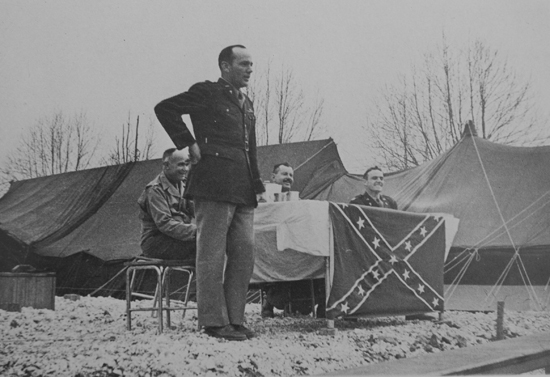
Lt. Colonel Staige D. Blackford delivers a speech to the personnel of the 8th Evacuation Hospital during celebrations of Jefferson’s Birthday, 13 April 1944.
On 15 June, the unit evacuated its patients, having treated nearly 1,500 casualties; 759 wounded or injured and 683 sick in the two weeks of operation. Of the patients admitted, 56.7% were evacuated to General Hospitals, 23.7% were returned to duty and 17.8% were transferred to other Fifth Army Hospitals. In total, 10 deaths were recorded, all from wounds or injuries.
A day later, the 8th Evac Hosp again joined in the advance. Breakfast was at 0400 hrs, the Hospital was ready to move when trucks from the 45th Infantry Division arrived at 0900 hrs, which were loaded in two hours and on the move by 1130 hrs. The convoy traveled 90 miles north of Rome near Orbetello where it halted. The trucks had to be unloaded for other duty, but the Hospital was not set up, and its personnel slept in the open. The site, it transpired, was not suitable, as once again it was too far from the front (almost 50 miles). After contacting the Fifth US Army Surgeon by courier, the 8th EH CO ordered the Hospital established 4 miles south of Grosseto. The following day (17 June 1944) after some more delays, the unit was once again moved with the help of about 20 trucks loaned by the 94th and 95th Evacuation Hospitals, to a site located only 6 miles from contact with the enemy.
The stay at Grosseto was short, and when the Hospital moved on 30 June, 812 wounded and injured and 447 sick had been cared for. It was the first area in the war where the wounded (621) outnumbered the admissions for diseases. The first week was one of the busiest the surgeons had experienced. Over 500 severe battle casualties were admitted in six days, all from wounds. For the first few days, almost half of the wounded patients were German.
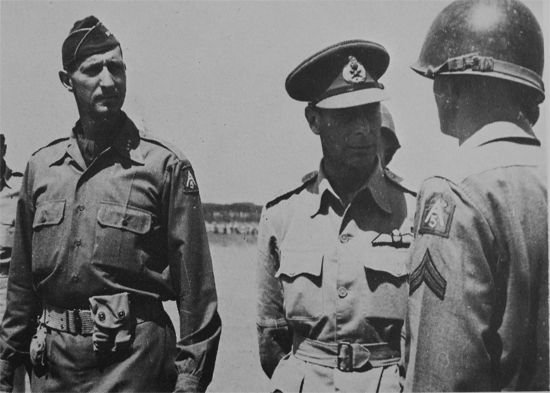
King George VI and Lt. General Mark W. Clark (CG, Fifth US Army) visit and inspect 8th Evac Hosp personnel during the unit’s time near Cecina.
On 2 July 1944 the 8th Evac moved into its fifth area in 39 days, after a 60-mile trip along Highway 1 to Cecina, moving into its outskirts while the fighting for the town was still in progress. The early part of the stay was a busy one with sick and wounded – it was also a time of an unusual number of visits from “top brass.” For example, on 6 July Henry L. Stimson (Secretary of War) – Lt. General Mark W. Clark (CG, Fifth US Army) – Maj. General Norman T. Kirk (Surgeon General), Maj. General Searles and Brig. General Joseph I. Martin (Fifth US Army Surgeon) arrived. The Surgeon General stayed for a lunch reception, where he remarked that the medical and surgical care in the Mediterranean theater was the best the world had ever seen.
On 13 July 1944 Colonel Lewis W. Kirkman, MC, arrived to assume command of the 8th Evac Hosp, relieving Lt. Colonel E. C. Drash, the acting commander since Colonel McKoan’s departure three months earlier. He soon gained the support of all in his command, and although somewhat unorthodox and informal in his manner, he retained the respect of all.
By 1 August 1944 admissions to the Hospital had slowed considerably. When the unit evacuated its patients by the end of the month, it had taken care of 5,547 patients; including 1,126 wounded, 638 injured and 3,736 sick. The organization operated a large ward exclusively for Italian civilians, of which over 200 were admitted, and the ward remained full until the capture of Leghorn. There were 51 deaths during this period, nearly all from severe wounds. Almost 40% of the patients were evacuated to Peninsular Base Section hospitals, 26% returned to duty, 28% were sent to the 3d Convalescent Hospital and the remainder, including Italian civilians were transferred to other Hospitals.
Northern Apennines & Florence:
On 30 August 1944 the 8th Evac Hosp moved eastward to a site near Galluzzo, six miles south of Florence on Route 2, a dusty, five hour trip. The main part of the Hospital complex was set up on flat ground at the bottom of a hill, and tents for personnel were placed on the surrounding knolls. On 1 September the Hospital began to receive patients. This period saw the beginning of the rain season, and part of the area was flooded. Luckily, the main part of the complex located and prepared with the season in mind, escaped. After several days of rain the Hospital was again nearly mired in mud.
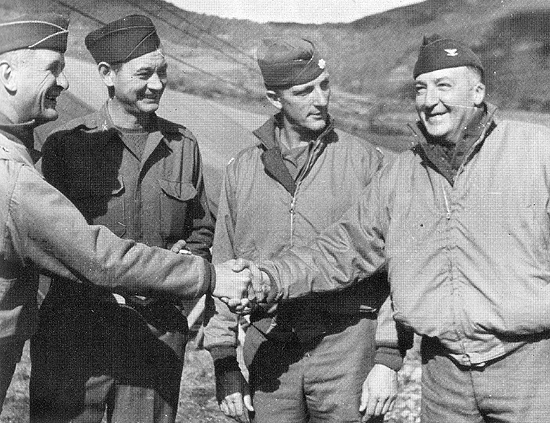
Brig. General Joseph I. Martin (Surgeon, Fifth US Army) meets Col. Lewis W. Kirkman (CO, 8th Evac Hosp), at Pietramala, December 1944. Also pictured here are Lt. Colonel Harry S. Holmboe (XO, 8th Evac Hosp), and Colonel Stan Grogan (Hq, Fifth US Army).
The period at Galluzzo was busy but not to busy to afford the personnel visits to Florence. Over the next few months, members of the Hospital became more familiar with Florence than they were with most American cities! On the afternoon of 25 September there was a sudden loud explosion that echoed around the Hospital complex. A group of Hospital staff rushed down to the area behind the Hospital and returned with a litter to the receiving tent. On it was a male Italian adolescent, both hands blown off, one eye missing, wounds in both legs. He died a few hours later despite immediate treatment. The incident caused strong emotions with the ward technicians of those wards exclusive to German prisoners.
From the time it opened on 1 September until it evacuated all patients on October 12, the Hospital took care of 5,267 patients, 3,106 sick and 2,161 wounded or injured. Despite the severe wounds seen, only 9 deaths occurred during this period. The load carried by the 8th Evacuation Hospital was largely relieved by the numerous other medical units in the area at the time (such as the 16th Evac, the 94th Evac, and the 15th Evac Hospitals).
On 13 October 1944, the 8th EH moved up Highway 65 to the vicinity of Pietramala, north of Futa Pass and just south of Radicosa Pass. Again, torrential rain had caused mud on the new site, and over 5,000 truckloads of rock were necessary for the 8th Evac Hosp to improve access roads and begin receiving patients. Rain, cold and fog occurred daily, almost continuously for the first three weeks. On 9 November the first snow fell, which covered the Hospital almost until March 1945.
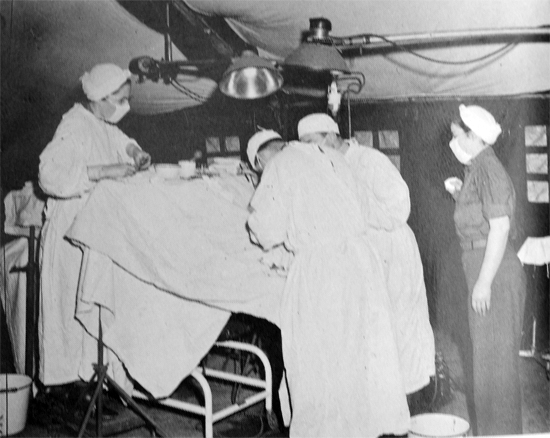
Operating Room in full activity. The photograph was taken in April 1944 during trials of a winterized OR complex.
With the halting of troops in the mountains south of Bologna, and the development of a winter stalemate, it became necessary to have a Hospital north of Futa Pass because winter snows sometimes blocked access. Accordingly, the decision was made to maintain the 8th Evacuation Hospital at Pietramala. In order to make this possible, the place was a real quagmire, a winterizing program was begun during the third week of November. This procedure was to be carried out by the engineers and the enlisted personnel of the hospital. The unit was sited in a rolling field, already churned to mud by heavy guns that were still there when the first loads of hospital equipment arrived. At least 5,000 truckloads of rock had to be used to maintain roads in the vicinity of the Hospital. When the program was completed, the Hospital had been transformed. Prefabricated buildings, each able to accommodate 40 patients, formed a row of wards. Other prefabs were assembled for shock wards and the x-ray room. The remaining ward tents and tents for personnel were winterized by the addition of floors, wooden sidewalls and doors. Yet, on 8 December, before winterizing was complete, a double ward tent, flooring, sidewalls and all, was lifted clear off the ground by strong winds, carried over six wards, and dropped on another tent. All together, 8 tents were blown down and many damaged. The Hospital census was low at the time and fortunately no patients were injured, but it was necessary to transfer 30 post-operative cases to the 15th Evac Hosp in Florence. A company of 53 Italian PWs was attached to the unit to help with housekeeping chores, particularly maintenance of a supply of fuel for the diesel oil and wood-burning stoves.

Overview showing the unit’s hospital complex at Pietramala.
At various times during this period, the staff of the 8th Evacuation Hospital was augmented by Nurses and Surgeons from the 2d Auxiliary Surgical Group, 38th and 94th Evacuation Hospitals, and the 12th, 17th, 23d, 26th, and 45th General Hospitals. These came as part of an exchange program which brought personnel of the General Hospitals to the Evacuation Hospitals for several weeks and let some of the personnel of the forward Hospitals work in the 24th General Hospital in Florence, and the 37th, 45th and 300th General Hospitals at Naples for the same period.
At Pietramala, the unit celebrated its third, best and final Christmas overseas, at the coldest spot on the II Corps front! At the Hospital, Christmas trees and mistletoe adorned each ward and mess, decorated by the Nurses. On Christmas Eve there was a service in the Chapel; with music provided by a quartet consisting of Capt. Northrup, M/Sgt. Robert Meckel, T/3 Robert Mitchell and T/5 Gordon Goodwin. The following day, each patient received a stocking made by the Nurses, who also prepared one for each man in the detachment. The stocking contained, amongst other things, a 12-ounce bottle of eau-de-vie which had been provided by the Officers.
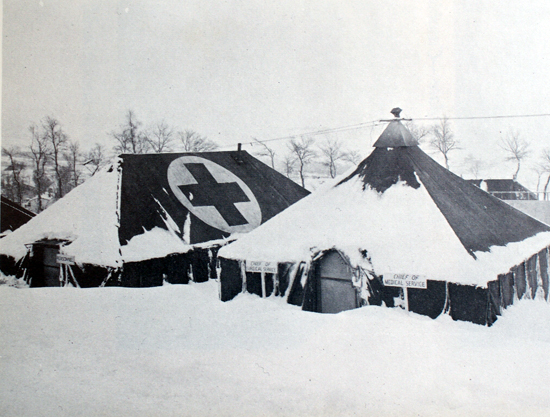
Photograph showing an M1942 Squad Tent and M1934 Pyramidal Tent belonging to the Chief of Medical Services at Pietramala.
While at Pietramala, the Hospital participated in the studies being carried out on infectious hepatitis, and during the winter of 1944 – 1945, Captain John Guerrant, MC, carried out a study of importance to men in the mess section of the 8th Evacuation Hospital and similar units, who were subjected to the fumes of gas and “white gas” from the field ranges they used. No significant illness was found, because the process cleared promptly when the men were assigned to other duty outdoors. The periodic screening tests carried out by Captain Guerrant provided adequate control of a situation that could have been potentially dangerous.
The stay at Pietramala saw a number of changes to the unit’s personnel. Major Paul Winthrop and Major Ray Siersema returned to the ZI for new assignments. Others, including Lt. Colonel Blackford, Captains Ross, Watson, Lindeke and Hrejsa, and Lieutenants Thomas, Canniff and Dearasaugh went home for a month’s temporary duty – the war would end before their TDY had ended. Major John O. McNeel was transferred to the 170th Evacuation Hospital to be Chief of the Medical Service of that unit.
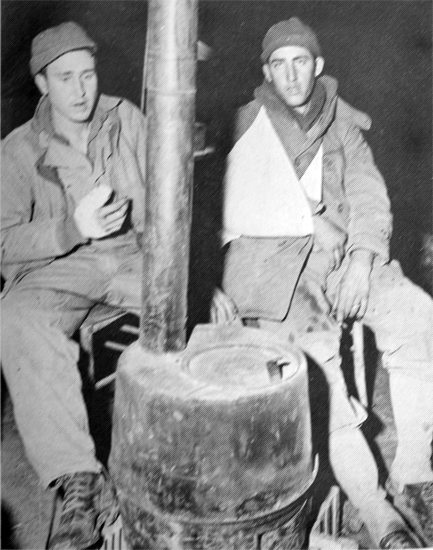
Newly arrived patients huddle around an M1941 Tent Stove before being officially admitted to the wards.
When the 8th EH evacuated all of its patients on 25 April 1945, it had spent six months in the site near Pietramala, its longest stay in any one area during the war. It had arrived in early autumn and remained until early spring. It had taken care of 9,113 patients, 4,700 of whom were injured or wounded. Because of the stalemate in the mountains the 8th Evac Hosp had served as the Evacuation Hospital nearest the front line longer than any other did during the entire North African or Italian Campaigns. Few members of the unit would ever forget the winter at Pietramala.
Return to Z.I.:
After waiting three days for transportation the 8th Evac on 29 April 1945 moved 125 miles to the vicinity of Verona. The first of 45 10-ton gondola trucks began arriving in groups of 5 at about 1500 hrs. The last of the trucks and ambulances of the 551st Motor Ambulance Company were loaded by 1230 hrs. The entire group clambered aboard a convoy that would take it through the mountains, across the Po River to a new site just south of Verona. First patients were already admitted on 30 April. Until the Po River was reached, enemy casualties were routinely evacuated to Fifth Army Hospitals, the 8th EH and the 94th Evacuation Hospital did however take on German casualties before leaving the mountain area in April.
On 28 May 1945, Colonel Lewis W. Kirkman who had been Commanding Officer for the previous ten months was transferred to the 15th Army Group Headquarters in Vienna, Austria. He was followed by Lt. Colonel. E. C. Drash, who became CO for the fourth time; on this occasion he continued until the Hospital was disbanded at the end of the summer. Early June a 100-bed detachment of the 8th replaced a platoon of the 32d Field Hospital at Desenzano. On 20 June the Hospital moved to the new area at Lake Garda, leaving behind a small portion which operated in the area near Verona until 23 July when it was closed completely.

Hospital equipment is packed up and prepared for shipment back to the Z.I. Note the numerous Food Cabinets stacked on the left hand side of the photograph.
Early on the morning of 17 July, unit member Corporal John Horwath was killed in an ambulance incident. He had been a member of the old 3d Evacuation Hospital and one of the original members of the 8th Evacuation Hospital when it was activated in August 1942. Chaplain Fleming held a requiem mass on 18 July and conducted funeral services at the American Cemetery on the following day. All of the Hospital personnel were truly saddened by the death of this popular member, a death that seemed particularly poignant and untimely, coming as it did two months after the war in Europe had ended.
In Verano, its final location, the unit had cared for almost 5,000 patients. The change in nature of the operations is shown by the distribution among the different categories of admissions; 3,544 sick, 1,065 injured and 210 wounded. After the patients were evacuated on 4 September the time was spent in housekeeping, on trips and excursions. By the 15th nearly everyone had received orders to report to the 27th Replacement Depot at Leghorn for shipment back to the United States’ Zone of Interior (the last Hospitals remaining active, after redeployment and disposition were the 15th Fld, the 8th Evac and 16th Evac Hosp). The 8th Evacuation Hospital was effectively inactivated in Italy on 30 September 1945. Personnel moved out in small groups when transportation became available, and several weeks were passed impatiently. Although some personnel sailed from Naples and other left singly or in pairs as Doctors on ships carrying troops home, the bulk of the remaining Medical Officers of the unit remained at Leghorn until they sailed on 16 October 1945 aboard the S/S Richard Basset.
The ship came into Chesapeake Bay shortly after daybreak on 1 November and docked at about 1100 hrs. Red Cross workers and WACs were on hand to welcome the troops with milk, coffee and doughnuts. Debarkation was rapid, and the men were soon in trains headed for Cp. Patrick Henry, a short distance away. From there, the men of the unit went to various Separation Centers in the country to be demobilized. Most of the original University group went on to Ft. Meade in Maryland, where the long-awaited process of demobilization was completed within a few days.
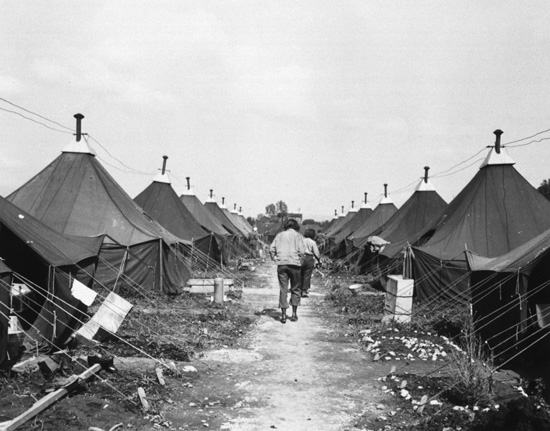
View of Nurses’ quarters, 8th Evacuation Hospital, Teano, Italy.
Courtesy History of Medicine.
The unit started its deactivation process on 5 September 1945 with following decorations having been awarded to its personnel:
6 x Legion of Merit
1 x Silver Star
2 x Soldier’s Medal
28 x Bronze Star
1 x Air Medal
7 x Purple Heart
The table below shows statistics for the patients that were admitted to the unit from its date of activation in 1942, until its last campaign in 1945:
| Date | Location | Disease | Injury | Wounded | Deaths | Total |
| 11/26/42 – 3/10/43 | Casablanca General Hospital VD Stockade La Dispenserie Maternelle |
3,522 603 859 |
609 | 61 | 3 | 4,195 603 859 |
| 3/18/43 – 6/19/43 | Prov. Convalescent Hospital | 706 | 433 | 320 | 0 | 1,459 |
| 10/16/43 – 12/10/43 | Caserta, Italy | 3,358 | 238 | 319 | 0 | 3,915 |
| 12/19/43 – 3/23/44 | Teano | 4,293 | 809 | 1,495 | 33 | 6,630 |
| 3/27/44 – 5/19/44 | Carinola | 1,060 | 310 | 598 | 9 | 1,977 |
| 5/21/44 – 5/30/44 | Cellole | 434 | 138 | 332 | 6 | 910 |
| 6/1/44 – 6/15/44 | Le Ferriere | 683 | 215 | 544 | 10 | 1,452 |
| 6/18/44 – 7/1/44 | Grosseto | 447 | 191 | 621 | 19 | 1,278 |
| 7/3/44 – 8/29/44 | Cecina | 3,736 | 683 | 1,126 | 51 | 5,596 |
| 9/1/44 – 10/12/44 | Florence | 3,106 | 458 | 1,703 | 9 | 5,276 |
| 10/14/44 – 4/25/45 | Pietramala | 4,713 | 1,413 | 3,088 | 85 | 9,299 |
| 4/49/45 – 9/4/45 | Verona – Desenzano | 3,544 | 1,065 | 210 | 28 | 4,847 |
| Total | 31,064 | 6,562 | 10,417 | 253 | 48,296 |

Illustration showing an X-Ray Technician at work at the 8th Evacuation Hospital.
Unit Roster:
The following is a list of members of the 8th Evacuation Hospital. The rank of each member is shown in parentheses wherever possible:
Officers:
| Lewis W. Kirkman (Col) John W. McKoan Jr. (Col) Lincoln F. Putnam (Col) Staige D. Blackford (Lt. Col) Everett C. Drash (Lt. Col) Harris S. Holmboe (Lt. Col) Edward W. Paulus (Lt. Col) Michael Q. Hancock (Maj) William R. Hill (Maj) Hubert B. Holsinger (Maj) Prentice Kinser Jr. (Maj) Edmund G. Laird (Maj) Byrd S. Leavell (Maj) Maurice L. LeBauer (Maj) John O. McNeel (Maj) George W. Northrup (Maj) Edwin W. Shearburn (Maj) Reynold C. Siersema (Maj) Samuel W. Windham (Maj) Joseph P. Winthrop (Maj) |
John B. Haley (Capt) Jack H. Hill (Capt) Howard P. Holt (Capt) Allen C. Hrejsa (Capt) Sigfrid Kinkopf (Capt) William H. Laird (Capt) Samuel M. Levine (Capt) Harold E. Lindeke (Capt) James R. Low (Capt) John R. Mapp (Capt) Donald F. Marshall (Capt) Henry W. Mayo Jr. (Capt) Linus J. Miller (Capt) Raymond A. Monin (Capt) John R. Morris Jr. (Capt) Edwin H. Mulford II (Capt) Henry J. Murphy (Capt) John W. Oast III (Capt) Thomas B. Payne (Capt) Francis A. Ross (Capt) |

Interior view of Shock Ward housed in a prefabricated building, 8th Evacuation Hospital, Italy.
Courtesy History of Medicine.
| Joseph E. Beck (Capt) Richard P. Bell (Capt) Samuel W. Casscells (Capt) Francis M. Churchill (Capt) Hylton K. Crotts (Capt) James W. Culbertson (Capt) Leon R. Culbertson (Capt) J. G. Damiens (Capt) Alfred A. Den Jr. (Capt) Leonard I. Dixon (Capt) Calvin S. Drayer (Capt) William D. R. Driscoll Jr. (Capt) James A. Felmming (Capt) Albert R. Gillespie (Capt) Kenneth B. Grim (Capt) Edward O. Groeber (Capt) John L. Guerrant (Capt) |
Alfred R. Shroeder (Capt) Herbert M. Smith Jr. (Capt) William P. Snavely (Capt) William G. Suhling Jr. (Capt) William N. Thornton Jr. (Capt) William E. Waddell (Capt) Donald P. Watson (Capt) Robert A. Weller (Capt) William H. Baldwin (1st Lt) Rex C. Blessing (1st Lt) Hugh Matthews (1st Lt) Asa M. Scarborough (1st Lt) William H. Baldwin (2d Lt) Elijah H. Jenkins (2d Lt) Raymond F. Lynch (2d Lt) Herbert L. Marin (2d Lt) |
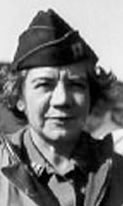
Portrait of Captain Ruth Beery (ANC).
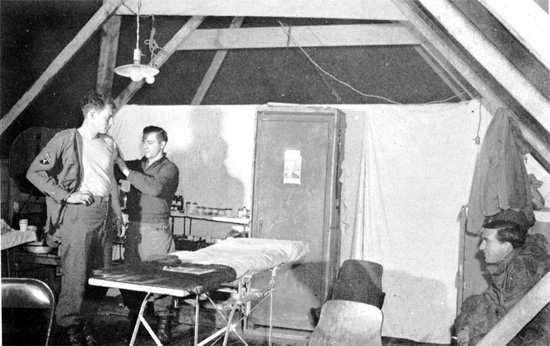
Overview of the Dispensary at the 8th Evac Hosp. Photograph taken in winter 1944.
Nurses:
| Ruth Beery (Capt.) Elizabeth F. Harlin (Capt.) Jane W. Anderon (1st Lt) Lillian M. Anderson (1st Lt) Helen Berkely (1st Lt) Sally E. Brightman (Hospital Dietian) (1st Lt) Angela J. Brusati (1st Lt) Laurel M. Canniff (1st Lt) Cathlene M. Carter (1st Lt) Lelia L. Cloyd (1st Lt) Madge R. Darden (1st Lt) Ethel M. Dearasaugh (1st Lt) Florence M. DeWitt (1st Lt) Rebecca Dofflemeyer (1st Lt) Mamie Donley (1st Lt) Nova J. Dowd (1st Lt) Alice L. Eagle (1st Lt) Lallah M. Edwards (1st Lt) Marjorie Foster (1st Lt) Hilde Franklin (1st Lt) Marie Galvin (1st Lt) Emma E. Garland (1st Lt) Lottie B. Gibson (1st Lt) Helen E. Gilkerson (1st Lt) Ella V. Gillespie (1st Lt) Mayme L. Griffitts (1st Lt) Margaret S. Hornbarger (1st Lt) Frances E. Houston (1st Lt) Alice M. Huffman (1st Lt) Gene Roush Jerabek (1st Lt) Elizabeth C. Johnson (1st Lt) Mamie E. Kidd (1st Lt) Alice C. Law (1st Lt) Mary J. McCone (1st Lt) Thelma L. Matthews (1st Lt) Ann M. Mickle (1st Lt) |
Christine C. Mills (1st Lt) Isabelle M. Muller (1st Lt) Clara E.. Orsini (1st Lt) Margaret A. Petersen (1st Lt) Beatrice M. Ramsey (1st Lt) Addie K. Roadcap (1st Lt) Kate S. Robinson (1st Lt) Dorothy D. Sandbridge (1st Lt) Mildred O. Smith (1st Lt) Thelma L. Springer (1st Lt) Fances Thomas (1st Lt) Jean F. Williams (1st Lt) Elizabeth Wiseman (1st Lt) Eula B. Wright (1st Lt) Ruby P. Armstrong (2d Lt) Mabel Ayers (2d Lt) Mary R. Beuka (2d Lt) Ruth Bustraan (2d Lt) Annie L. Dickson (2d Lt) Minnie L. Dozier (2d Lt) Ruth Eastman (2d Lt) Elizabeth Engleman (2d Lt) Mary Ellan Gibson (2d Lt) Dora Guglielmetti (2d Lt) Myrtle Hatcher (2d Lt) Margaret McGown (2d Lt) Dorothy Melusky (2d Lt) Josephine Montecalvo (2d Lt) Grace M. Musolini (2d Lt) Margaret Phillips (2d Lt) Janet M. Reed (2d Lt) Gertrude K. Rowell (2d Lt) Roberter L. Taylor (2d Lt) Frances E. Wells (2d Lt) Lucille White (2d Lt) |

From L to R: Colonel Lewis W. Kirkman + Lt. Colonel Staige D. Blackford + Lt. Colonel Everett C. Drash + Lt. Colonel Harris S. Holmboe
ARC Detachment:
| Ruth S. Buffington | Frances S. Carter |
Enlisted Men:
| Everett P. Aaron (Pfc) Benjamin A. Adams Herbert R. Adams (T/5) Roscoe W. Adams F. N. Akers (T/5) Leroy A. Alderman (T/5) John Alexsevich (Pfc) Alphonse L. Amendola (Pfc) John J. Amrozy (Cpl) Charles L. Amsden James M. Andel (Cpl) Edward G. Anderson John F. Anderson (T/4) William J. Anderson (Pvt) Robert Anoe J. Vincent P. Antisdel (T/4) Albert J. Archibald Lloydy R. Arend William M. Arendt Warren C. Artwell (T/5) Harold F. Atwood Jerry A. Aveta (Pfc) Charles E. Babcock Can Baird (Pfc) Berl G. Baker (Pvt) James D. Baker (Pvt) John W. Baker (Pvt) Herman W. Ball (Pvt) Edward J. Bankes (Pvt) Dana E. Banning (Pvt) Morton S. Bara (Pvt) Homer G. Barber (T/5) Bennie J. Barcak (Pvt) Raymond J. Bard (Pvt) Charles H. Baker Charles R. Barnes Leonard A. Barnes Fred T. Bartley (Sgt) |
Arthur F. Labrado Virgil Lambert (T/4) Thomas B. Lane (T/4) Harvey H. Langeliers Robert W. Langston John E. Lanzendorfer (T/5) Sebastian T. LaRosa (Pfc) Marvin E. Lasater Joseph J. Lawlor Lone F. Lee (Pvt) Tribble J. Lee (Pvt) James M. Leith (Pvt) Don Leland Ralph L. LeVan (Cpl) Paul J. LeVay (T/5) Jessie M. Lewis (Pvt) Charles T. Liles (T/5) Bruno Lisi William W. Little (Pvt) Francis X. Littrell (Pfc) Honie W. Loggins (T/5) Olav G. Lokken (Pvt) Herbert L. Lorah (Pfc) Anthony T. Losciuto (Pvt) Robert W. Lovett Frank L. Lowther (T/5) Alex W. Lucas (S/Sgt) Leo B. Lynch (T/5) Julius A Lynn () Alton Ci. McClarty (Pfc) Jimmie M. McClcndon (Cpl) George L. McDonald Willis McDonald (T/5) Gordon A. McEwan (Pvt) Joseph E. McCiee (Pvt) Lewis J. McGlinsey (Pvt) Emmett F. McGuirc (T/3) |
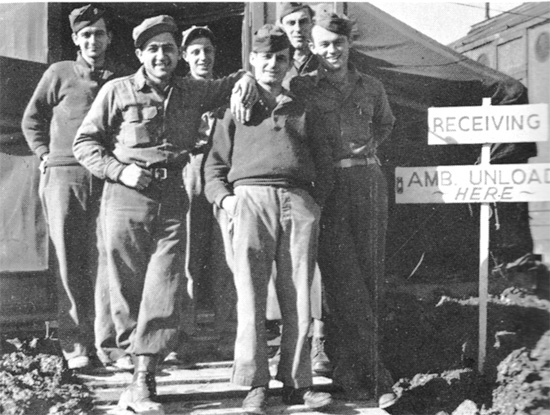
Photograph of Receiving Staff. From left to right: Sgt. Didier, Pfc. Buonovicino, Pvt. Wanderer, Cpl. Horwath, Cpl. De Ross, Sgt. Salmon.
| Anthony J. Basan Arthur J. Beacon (S/Sgt) Harold E. Beal Floyd L. Beasley Arthur J. Beacon (S/Sgt) John A. Beaty Thurmond Bell (Pfc) Erwin A. Bender (Pfc) Don J. Bickler (Pvt) Sigmund J. Bielawski (Pvt) Louis A. Bieringer John Biernacke (Pvt) James W. Biggar (Cpl) Robert E. Biggs (Pfc) Leo Bischke Harold R. Bjorklund (Pfc) Carroll D. Black (T/4) Walter E. Blackston (T/3) James W. Biggar (Cpl) Robert E. Biggs (Pfc) Leo Bischke Harold R. Bjorklund (Pfc) Carroll D. Black (T/4) Walter E. Blackston (T/3) James N. Blake Joe V. Blake (T/4) Julius Bloch Aaron J. Bogatsky (T/5) Ernest H. Boje (Pfc) Joseph Boland Lloyd H. Bollinger (Pvt) Demetri C. Boosalis (Pvt) William R. Bostic (T/4) Laurence W. Botimer (Pvt) Henry Bowman (T/5) John S. Bozsik (T/4) Frank M. Bramlett (T/5) Robert G. Bramlette (Pvt) Robert L. Breese (Pvt) Cecil O. Brougher (Pfc) William O. Brown (Pvt) Floyd Bruning Herman L. Brush (Pvt) Dana E. Bunning (Pvt) Rocco A. Buonovicino (Pfc) Samuel T. Byers Harlan P. Caldwell (Pvt) Raymond L. Callahan (Sgt) Raymond E. Canipe (T/5) John E. Carlton William Carnes Charles C. Carpenter (T/3) Gerald L. Carpenter (T/4) Jessie Carpenter James L. Carter (T/4) Cosmo C. Castigliego (Pvt) Avery Chait (Pfc) Lionel R. Chartier (Pvt) William R. Chewy George W. Child (Pfc) Tyrol C. Christian (S/Sgt) Charles Church (Pfc) Alvin D. Cobb Yale Cohcn (T/4) Richard Cole Gregg Conley George Cook Henry Cook Robert I. Cook (Pvt) Wilford D. Cook (Pvt) Alfons Coppola John Carlese (Pfc) Frank Coste Roland F. Cox (Pvt) Edward D. Creason (Sgt) Elmer J. Crosby (Pvt) Charles Croy Jr. Ralph Culver (Ralph S) Lee W. Cummings (Sgt) Samuel Curtis (Pfc) Elic Davis (Elic M) John C. Dawson (T/4) George Day (Sgt) Clayton E. Dean (T/5) Francis Dean Willie A. Deaton (T/5) Edward P. Deegan (Pvt) William B. Deibert (T/5) Merle Delaney John W. Dempsey (T/5gt) Edward Denny (Pvt) Willis E. De Ross (Cpl) William A. Derryberry (Sgt) William E. Dettore Emmanuel A. Didier (Sgt) Radcliffe H. Dittmar (Pvt) James W. Dolan (Pvt) James Donofrio Max S. Dorfman Horace Downing Raymond H. Dreese (Pvt) John Drewry Clarence Dugay Joseph Duidale Harry L. Dumbleton (T/4) Harvey Durgin Albert G. Dykes (S/Sgt) James R. Eason Edson Elkins (Pfc) Elmer P. Ellington (T/3) Edward Elliott (Pfc) Francis X. Ely Jr. Donald H. Enssle (Pfc) Ferdinand C. Erk (S/Sgt) Durill J. Evans |
Modoc L. MeKenzie Harry T. McLaughlin (Pvt) Robert P. McNamara (T/4) Frederick D. McNish (Cpl) Thorborn E. McNulty (T/5) George R. McPhillips (Pvt) Lloyd W. Maheras (Pvt) Clair Mahoney (Clair V) Matthew Mallahan (Pvt) Gerald R. Mallow (T/4) Charley M. Malone (Pvt) Raymond J. Marceau Marion G. Martin (T/4) John E. Martinich Randall E. Marvin (Pvt) James G. Massey (T/5) George B. Mattila (T/5) Julian G. Mattocks William F. Matzen (Pfc) Paul Mayer (T/5) Robert C. Meckel (M/Sgt) Thomas L. Medlin (Pvt) John C. Meehan Norman E. Menck (T/4) Eugenio A. Mendez (T/4) Sam Mendiese Jr. James H. Menzies (Pfc) Vincent Messina (Pvt) Rogert C. Metcalf (Sgt) Paul Meycr (Pvt) Arthur S. Middleton Jr. Paul R. Miles (T/4) Henry Miller (Pvt) J. B. Miller Lee R. Miller Louis L. Miller (Pvt) Troy L. Miller (Pfc) Wallacc P. Miller (Pfc) Cecil A. Milling (Pfc) Robert F. Mitchell (T/3) Ernest M. Montgomery (T/3) Ivor R. Moon (Pfc) William Moore (Pfc) Samuel B. Moreland (Pfc) Wayne Morken (Pvt) Marvin Morris (Pvt) Russell C. Morris (Pvt) James H. Moss (S/Sgt) Theodoric Q. Moter Walter T. Mounce (T/4) Egbert E. Mullins (T/4) Allen J. Murdock (Pvt) William E. Murphy Samuel A. Napolitano (Pvt) Adam E. Naporski (T/5) Daniel Nash (Pvt) Hilton E. Nau (T/Sgt) John T. Neal (S/Sgt) Han Needham (Han C) Hilmer E. Negethon (T/5) Frederick J. Neumeister (T/5) John L. Newman (Cpl) Joseph Nocero (Joseph R) Adlo Nordmarken (Adlo E) Jesse J. Nugent (Pvt) Edward R. Oakey (T/5) Nash B. Obenchain (T/5) James M. O’Bryan (Cpl) Edward H. O’Conncll David M. Ogren (Cpl) John M. O’Hara (Pvt) Louis F. Olds (Pvt) Charles H. Oliver (Pvt) Florian J. Oppek Harold Orringer (Pvt) Alexander Overvold (T/3) Claude Owens Anthony Padula (T/5) James A. Page (Pvt) Martin G. Parkhurst (T/5) Robert B. Pavlatos (Pvt) Mose G. Payette (Pvt) Michael Pelts Marion Penland (Marion W) John Peoples (John L) Elvio B. Perotti (Pvt) Wilburt C. Perry (Pvt) James J. Peterson (Pvt) William Peterson George C. Petrovitz (T/5) Martin Petruzzi Thomas H. Petty (T/4) Eldon H. Pevey (T/5) Norris R. Philbeck (T/4) Harold C. Phillips (Pfc) Ira Pierce (Pvt) Joseph E. Pierce (Sgt) Francis E. Plaisted (T/5) Myron A. Plante (Pfc) Bernard B. Plucinski (Pfc) Edward Plunkett Robert L. Pond (Cpl) Anderson Pope (Pfc) Hoyt C. Porter Russell W. Powell (Sgt) Morrell B. Pratt (T/5) William H. Pratt (Pvt) Carl A. Pravilz Arthur R. Preis (T/5) Foster Prevatt Warren H. Prigge (Pvt) Dan Proffitt Andrew M. Rabuck (Cpl) Charles L Rabun (Pfc) Martin O. Raddatz (T/5) |
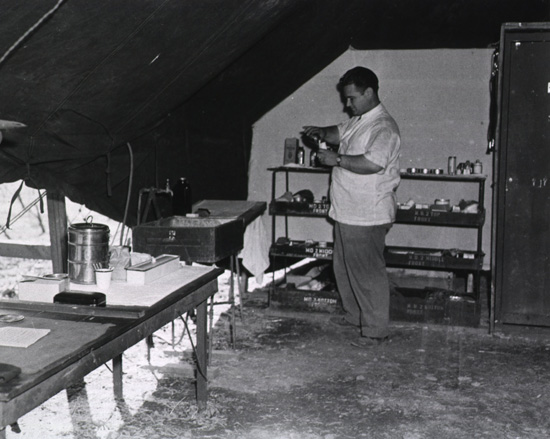
Another view of the Dispensary at the 8th Evacuation Hospital, while established at Lake Garda, Italy.
Courtesy History of Medicine.
| George F. Evans (Cpl) Fred K. Facundus (S/Sgt) Carson R Fails (Pvt) Isaiah Falb Estell R. Felts (T/4) James D. Ferguson (Sgt) Merle D. Ferguson (T/5) Willis G. Ferguson (Pfc) Aaron E. Fisk (Pvt) Manuel Flanagan Ralph A. Fleming (T/5) Robert W. Forsha (Pvt) Glenn R. Fox (Sgt) William Fox Kenneth A. Fradenburgh (T/4) Charles C. Frain (T/5) Louis Frank (Pfc) George Franke (Pvt) Lambert Franke Dewey Franks (Pvt) Robert R. Franzdorf (Pfc) Nathan Freedman (Sgt) Everctt Frink Emmett J. Fritz Jr. Regis A. Fritz (T/5) George D. Funds (Cpl) Stephen J. Galuk Ludie W. Garrett (T/5) R. F. Gasiorowski (T/4) Herbert Gauper Lovett E. Geeslin (T/5) Elmer Gentry (Elmer A) Frank Geoffroy (Pfc) Charles J. George (Pvt) Raymond C. George (Pfc) Anthony C. Giannini (S/Sgt) Jay W. Gilbert James F. Gilreath (T/5) Christos Giotis Gordon E. Gladue (Pvt) Sheldon Glaser (T/4) John E. Gleason (Pfc) Archie B. Glover Jr. Richard A. Goddard (Pfc) Carlos Goins Manuel M. Gomez (Pfc) Gordon E. Goodwin (T/5) John H. Gordon (T/5) Warren J. Gore Howard E. Grace (Pvt) Lowell W. Gram (T/5) John W. Gramelt (T/4) George W. Grannon (Pvt) Richard A. Grant (Sgt) Walter P. Gray (T/4) Samuel H. Green (Pvt) Aaron F. Greer (T/5) Vernon Griffitts John N. Griggs (Pvt) John R. Grimes Lawrence Gross (Pfc) Harry J. Grossman (Sgt) Stanley C. Groszek (Pvt) Paul Grzymkowski (Pfc) Frank Guastella (Pvt) Harold L. Guell (Pvt) James Gumm Carol D. Gustafson (Pvt) Floyd H. Gustavel (Pvt) John Haas Albert Hackworth Jean F. Hagemann (Pfc) Claude H. Hall (T/5) Origen C. Hall (Pvt) William J. Hall (Pfc) Richard D. Hamill (Pfc) Leroy C. Hamilton Werner L. Haney (Pfc) Joseph A. Hardigan (Pvt) Garnett E. Hare (Pvt) Jake Hargrove (Jake C) Robert R. Harkness (Cpl) Albert Harlan (Pvt) Stephen D. Harmon George T. Harrell (T/3) Lawrence H. Harrison (Pvt) Shively Hartfield (Pvt) Robert B. Hartman (T/4) Wilbur A. Haynes Jeff T. Heatherly (M/Sgt) Clifton P. Hebert Edward M. Heidel (Pvt) Harold J. Helmink (Pvt) Thomas C. Hembree Virgil E. Hendershott Francis Hendley Quincy F. Hendricks (Pfc) Adolphus P. Herrin Thomas J. Hession Glen J. Hildebrant (Pvt) Walter C. Hill (T/5) George M. Himmelberg |
William Radford Otto Ratajesak Samuel Raymond Rush Razee Jr. Floyd N. Rear (Pvt) George Redynger George L. Reiley (Pvt) Jacob Reinstein Joseph Ribar Hubert Rice Frank Ripley Miguel Rivera (Pvt) William E. Robertson (Pvt) Elmer E. Robinette (T/4) Clarence A. Robinson (Pvt) Walter H. Rockwell (Pfc) Edwin L. Rodecap (T/5) Lance G. Rodseth (Pvt) Williams H. Rogers (S/Sgt) Edward J. Romano (Pvt) Alfonso L. Romero (T/5) Elmon A. Root (Pfc) Marvin C. Rosumny (S/Sgt) James B. Rountree (Sgt) Orville R. Rugg!es (T/5) Harold E. Rupe (T/4) John St. Onge (John H) Ardcn J. Salisbury (S/Sgt) James Salmon (Sgt) Sampatis Sampatacacus Donald Sams Emil Samucison (Pvt) Claude H. Sanchez (S/Sgt) Albert Sanders (Pfc) Lloyd Sawyers (Pfc) Clare J. Schram (T/3) Frederick H. Schreck (T/5) Lester H. Scott Troy Segers Howard Sewell Edward J. Shaw (Pvt) I. G. Shaw Donald O. Shell James B. Sheppard (T/5) Paul E. Sherman (Pfc) Edwin J. Shriver (T/5gt) Wayne L. Shular (Sgt) Hubert Simmons (Pfc) Willard W. Simmons (Cpl) Anthony B. Sinkoski (Pvt) Arnold Sleeman (Cpl) John C. Smart (S/Sgt) Clarence G. Smiglewski (T/3) Green W. Smith (Sgt) Herman E. Smith (S/Sgt) Marion E. Smith (T/5) Thomas L. Smith (T/4) Wilson L Smith (Pvt) Cleus A. Smyser James D. Snyder Fletcher E. Spann (T/5gt) Nathan Sparks (Sgt) Martin E. Stafford (T/5) Robert E. Stanford (T/5) Clinton H. Staton (T/5) John F. Steinacker Jr. Alexander Stepura Harry C. Stetzel (Pvt) George Stevens Alexander Stevenson Charles E. Stewart Eustace Stewart Harold S. Stewart John T. Stich (Pvt) Charles W. Stone (Pvt) Oscar D. Strauss (Pvt) Frank B. Stromski (T/5) Paul H. Stuck (Pfc) Paul Stueness (T/4) Frank Suda (Pvt) Robert J. Summers (Pfc) William J. Summers (T/5) Fred K. Sutton Carl E. Swift (Pfc) Milton Swink Homer Tackett James R. Tanner Woodrow Tanner (Pvt) Gordon Tatum Everctt Taylor (Pvt) Harlan H. Tevis (T/4) Thomas A. Thill (Pvt) Armand A. Thomas (Pvt) Claude E. Thomas (Pvt) Guy Thomas Ova D. Thomas (Pvt) Edward A. Thompson (T/5) Frank Thompson (Pvt) John W. Thompson (M/Sgt) Charles Tolbert Thomas Tomich Maynard W. Tooker (Pvt) |

British Prime Minister Winston Churchill photographed while visiting the 8th Evacuation Hospital during the unit’s time in Italy.
| Robert M. Hobson (Pvt) Louis R. Hoff (Sgt) Theon L. Hoffer (Pvt) John F. Hoffman John T. Hoffman (Pvt) Thomas F. Hogan Nicholas Holly Sheldon Horton (T/55) John L. Horwath (Cpl) Lawrence B. Hostetter Woodrow Howard Edward M. Hudson Jr. John Hume (John E) Kelly Ilunley Dudley H. Husz (T/5) Nicholas R. Iannuzzelli (Cpl) Elrner Ihnken (Pvt) Paul F. Incorvia (Pfc) Charles C. Irby William C. Irvine (T/5) Alvin E. Isberner James E. Jackson Stanley Jacobs Steven E. Jarik (T/3) William J. Januski Fred Javotski Jack B. Jensen Joseph P. Jesko Frank Jr. John (Pvt) Earl W. Juhnsmcycr (T/4) Frank R. Johnson (T/4) Frcderic R. Johnson (Pfc) Louis E. Johnson (T/5) Walter G. Johnson (Pvt) James D. Johnston (T/5) Wilburn C. Jolly (Cpl) Donald Jones (Donald M) Alexander Jouchko (Pvt) Wrought B. Justice (Cpl) Walter J. Kaczka (Pvt) Peter P. Kalamick (Pvt) Owen V. Kavanaugh (T/5) Bruce B. Kce (Pvt) Earl J. Kecler (Pfc) Walter L. Kester (Pfc) Harold W. Key (T/3) James J. Key (Pfc) Robert E. Kincade Jonathan W. Kindred John J. King (Pfc) Theodore L. King (T/5) Ray Kirsch (Pvt) Roy A. Klaus (Pfc) Roy C. Klcen (T/5) Julien F. Kline (Sgt) Troy E. Kloefkorn (Sgt) J. L. Knight (S/Sgt) Jessie W. Knowles (Pfc) Donald O. Knox (Pvt) John J. Koczan (Pfc) George Kokinakis (Pfc) Veron F. Konersmann Frank J. Kost (Pvt) Frank E. Krigel Frank J. Krsul (Pvt) Anthony S. Krukowski (T/4) Joseph G. Kucian Thaddcus J. Kuna (T/5) Lyle C. Kurdelmeier Raymond D. Laatz (Pvt) |
John F. Townsend (Pvt) Albert J. Troutman (T/5) Barnett A. Tubin (Pfc) Beverley D. Tucker (T/5) John G. Tudor (Pvt) Wilbur Turpen (Pfc) Luton M. Tweedy Gene A. Uebel (T/4) Albert Vacinek Raymond Valenzuela Arthur J. Vallec (Pfc) Clyde E. Vance Vernon Van Vickle Edward Varcella William Vaughan Edward L. Vickery (T/5) Samuel W. Waddell (Pvt) George A. Wagner (Pvt) Jack Waldman (Pvt) Herbert Wallace (Pfc) Roy Waller (Sgt) John H. Walpole (T/5) Gustave Wanderer (Pvt) Bish Ward (Pfc) Eugene Ward (Pfc) William Ward Jacob N. Warden (Pvt) William D. Ware (S/Sgt) Hoyt Waycaster Glenn Weaver Austin Webb Harold Weiler George T. Welch (Pvt) William H. Weldon (Pvt) Sigmund J. Wernicki (Cpl) Alton O. Werth (Cpl) Harold H. West Arthur Wetzel (Pvt) Ivan R. Whaley (T/5) John F. Whatley (Sgt) Charles E. Wheeler (Pfc) George Wheeler Francis J. White (Pvt) George White Thomas White Orval K. Whitman (Pvt) Edmund G. Whittenberg (Pvt) Edward G. Wicks Lloyd E. Wilcoxon (T/5) Ollie J. Wilhelm (Cpl) Arthur Williams Charles H. Willy (Pvt) Osmer S. Winborne (Pvt) James C. Winebrenner (T/5) George R. Windler (T/4) Fred A. Winkler (Cpl) William T. Wise Jr. Richard C. Witt Steve Wojcik (Pvt) Clyde Wolford Edgar W. Wolka (T/4) Howard W. Wood (Pfc) James A. Wood (Pfc) James W. Wood (S/Sgt) Norman E. Wood Harry C. Wright (T/4) Edwin V. Yeagley (T/4) Phillip R. Yost (T/4) Fred E. Young (T/5) Cecil F. Zuberer (Pvt) |

Group of Officers and Nurses of the 8th Evacuation Hospital, Casablanca, French Morocco.
